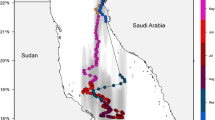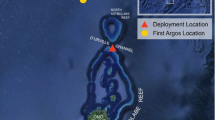Abstract
Defining the location and habitat characteristics of areas of aggregation of Atlantic shark species has been identified as an important information need for current and future management efforts. The primary objective of this project was to investigate the depths and temperatures of the waters occupied by large juvenile sandbar sharks of the northwest Atlantic population during the winter months and the overwintering localities of these animals using a fishery independent method. During the summer of 2003, 21 sandbar sharks captured in the Eastern Shore of Virginia bays and lagoons were outfitted with satellite transmitters that were programmed to detach during the following winter. The sharks occurred in significantly colder and deeper waters during the winter period than during the summer nursery period with a mean depth and temperature recorded by the transmitters during the winter period of 19.9°C and 20.8 m and a mean depth and temperature recorded during the summer period of 24.0°C and 4.3 m. Despite this decrease in temperature and increase in depth of occurrence, the sharks remained in relatively warm waters and shallow depths throughout the overwintering period. Satellite pop-off locations during the overwintering period were concentrated in central North Carolina coastal waters, where a unique combination of shallow depths and warm temperatures may contribute to the survivorship of these animals while they overwinter in these waters.





Similar content being viewed by others
References
Arnold G, Dewar H (2001) Electronic tags in marine fisheries research: a 30 year perspective. In: Electronic tagging and tracking in marine fisheries. Kluwer Academic Publishers, Dordrecht, pp 7–64
Conrath CL, Musick JA (In Press) The sandbar shark summer nursery within the bays and lagoons of the Eastern Shore of Virginia, Transactions of the American Fisheries Society
Epperly SP, Braun J, Chester AJ et al (1995) Winter distribution of sea turtles in the vicinity of Cape Hatteras and their interactions with the summer flounder trawl fishery. Bulletin of Marine Science 56:547–568
Grubbs RD, Musick JA, Conrath CL et al. (In Press) Long-term movements, migration, and temporal delineation of summer nurseries for juvenile Carcharhinus plumbeus in the Chesapeake Bay region. In: McCandless CT, Kohler NE, Pratt HL Jr (eds) Shark nursery grounds of the Gulf of Mexico and the East Coast waters of the United States. American Fisheries Society, Bethesda MD
Grusha DS (2005) Investigation of the life history of the Cownose Ray, Rhinoptera bonasus (Mitchell 1815). Thesis, Virginia Institute of Marine Science, College of William and Mary
Jensen CF, Hopkins GA (2001) Evaluation of bycatch in the North Carolina Spanish and king mackerel sinknet fishery with emphasis on sharks during October and November 1998 and 2000 including historical data from 1996–1997. Report to North Carolina Sea Grant Project #98FEG-47
Mansfield KT (2006) Sources of mortality, movements and behavior of sea turtles in Virginia. Virginia Institute of Marine Science, College of William and Mary, Dissertation
Merson RR (1998) Nurseries and maturation of the sandbar shark. University of Rhode Island, Dissertation
Merson RR, Pratt HL Jr (2001) Distribution, movements, and growth of young sandbar sharks, Carcharhinus plumbeus, in the nursery grounds of Delaware Bay. Environmental Biology of Fishes. 61:13–24
National Marine Fisheries Service (2003) Final amendment 1 to the fishery management plan for Atlantic Tunas, Swordfish, and Sharks. http://www.nmfs.noaa.gov/sfa/hms/hmsdocument_files/FMPs.htm Cited 9 October 2005
National Marine Fisheries Service (1999) Fishery management plan for Atlantic Tunas, Swordfish, and Sharks. http://www.nmfs.noaa.gov/habitat/habitatprotection/efh/fisheries_mgmt.htm#hapc Cited 9 October 2005.
Sminkey TR, Musick JA (1995) Age and growth of the sandbar shark, Carcharhinus plumbeus before and after population depletion. Copeia 4:871–883
Springer S (1960) Natural history of the sandbar shark, Eulamia milberti. Fishery Bulletin 61:1–38
Acknowledgements
We thank P.G. Ross, S. Fate, A.J. Birch, E. Smith, G. Arnold, and R. Bonniwell for excellent field and logistical support. Thanks to the VIMS shark project for assistance rendered, particularly J.S. Smith, L. Pace, J.Romine, and D.S. Grusha. Funding for this project was provided by Saltonstall-Kennedy Grant # NA17FD2365 and by the National Shark Research Consortium.
Author information
Authors and Affiliations
Corresponding author
Rights and permissions
About this article
Cite this article
Conrath, C.L., Musick, J.A. Investigations into depth and temperature habitat utilization and overwintering grounds of juvenile sandbar sharks, Carcharhinus plumbeus: the importance of near shore North Carolina waters. Environ Biol Fish 82, 123–131 (2008). https://doi.org/10.1007/s10641-007-9263-0
Received:
Accepted:
Published:
Issue Date:
DOI: https://doi.org/10.1007/s10641-007-9263-0




